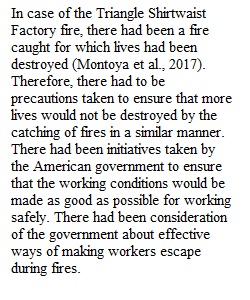


Q In this assignment, you will consider the relationship between labor and management in the context of two important events: The Triangle Shirtwaist Factory fire and the Ludlow Massacre. To get started, click the MindTap link in the Get Started Module and follow the directions below: • Navigate to Unit 5: Western Transformation, Industrialization, and Reform and click the drop-down arrow on the right. • Select the drop-down error on the left for Chapter 16: The Making of Industrial America. • Select the drop-down for Review and Test Yourself • Select Chapter 16 Primary Source Writing Activity: The Making of Industrial America Interactive Timeline. • When the activity opens, read the background information and the writing prompt. • Then click the The Making of Industrial America Timeline link in the activity to start gathering information for your response. Your response should be 2-3 paragraphs in length, and should meet the following criteria: • It addresses all portions of the topic or prompt. • It has a fully developed thesis. • Ideas are stated clearly and easy to understand. • Major supporting ideas are thoughtful, readily identi?able and well-developed in uni?ed paragraphs with concrete, substantial and relevant information. • It demonstrates command of language, with precise word choices, and few—if any—errors in usage or mechanics. When you’re done, submit your work to your instructor using the Turnitin link at the bottom of the Assignment page in Canvas. (Do not submit via the writing prompt window.) At the turn of the twentieth century, conflicts between labor and management shook the expanding industrial sector, sometimes culminating in violence. In November of 1909, in response to protests by workers at the Triangle Shirtwaist Factory, twenty thousand garment workers went on strike in New York City in what became known as the Uprising. For most, the strike resulted in a contract for the unionized workers. The Triangle Shirtwaist Company, however, refused to sign. A little more than a year later, the factory was the site of a fire in which 146 people died. In April 1914 in Colorado, violence erupted once again in what became known as the Ludlow Massacre—after which the workers made significant gains, such as the possibility of organizing company unions. Despite some similarities, the Triangle Shirtwaist Factory fire and the Ludlow Massacre played out very differently for the workers involved. What factors were responsible for the different gains made by labor in these two events? Had labor relations evolved in the twenty years between the two events? How? What factor did geography play in the two strikes, between the dense industrial East and the open mines of the West? Explore the interactive timeline below and write your response in the space provided. The Making of Industrial America Timeline
View Related Questions